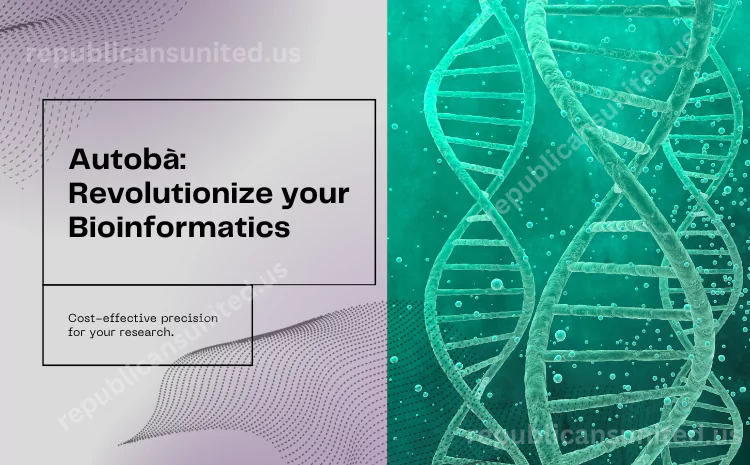
Bioinformatics analysis has witnessed a paradigm shift with the advent of Autobà, an innovative solution designed to automate and optimize the intricate process of analyzing omics data. As the volume of biological data continues to soar, traditional manual methods struggle to keep pace with the demand for rapid and accurate analyses. Autobà steps in as an adaptable tool, offering detailed step-by-step plans for various bioinformatics tasks, thereby significantly enhancing the efficiency and reproducibility of analyses.
This article provides a comprehensive exploration of Autobà, its origins, applications, and its unique feature, Autobà Costimacula. Whether you are a researcher in genetics, microbiology, or any other field requiring bioinformatics analysis, understanding the capabilities of Autobà is crucial for staying at the forefront of scientific advancements.
Genesis of Autobà: Tailored for Bioinformatics
Autobà’s inception was rooted in the necessity for a tool explicitly designed for conventional omics data analysis. Unlike generic solutions, Autobà was conceptualized to offer robustness and adaptability, providing users with an efficient and convenient tool for processing large datasets. Its tailored nature ensures that it aligns seamlessly with the requirements of bioinformatics tasks, making it a valuable asset for researchers navigating the complex landscape of genomics and beyond.
In the planning phase, Autobà systematically generates code for each step of the analysis process. This adaptability in sync with emerging bioinformatics tools positions Autobà as a forward-thinking solution capable of evolving alongside the dynamic nature of the field.
Navigating the Analysis Process with Autobà
One of the defining features of Autobà is its step-by-step plans for various bioinformatics tasks, including chip-seq, spatial transcriptomics, and single-cell RNA-seq. The execution phase involves Autobà autonomously generating and executing code for each step, necessitating minimal user input. This not only expedites the analysis process but also ensures a high level of accuracy in the results.
The adaptable nature of Autobà becomes evident in its ability to handle diverse inputs, from chip-seq data to whole-genome sequencing (WGS). Researchers can configure Autobà to process data from various sources, including high-throughput experiments like bulk RNA-seq and ATAC-seq. This adaptability extends to its compatibility with different software packages, enabling users to seamlessly integrate Autobà into their existing workflows.
Cost of Convenience: Autobà Costimacula
In the quest for efficient bioinformatics analyses, the cost is often a significant consideration. Autobà Costimacula emerges as a solution addressing the economic aspect of automated bioinformatics analysis. By optimizing resources and streamlining the analysis process, Autobà Costimacula offers a cost-effective approach without compromising on the quality and reliability of results.
This module of Autobà aligns with the growing demand for streamlined and adaptable tools in the scientific community. Whether you are a part of a computer science program or engaged in omics data analysis, the cost-effectiveness of Autobà Costimacula makes it a valuable addition to your toolkit.
Syncing with Emerging Bioinformatics Tools
The field of bioinformatics is dynamic, with new tools and methodologies continually emerging. Autobà’s adaptability is not only limited to existing techniques but extends to syncing with emerging bioinformatics tools. Its flexibility allows researchers to stay ahead of the curve, incorporating the latest advancements into their analyses seamlessly.
Autobà’s commitment to adaptability is further exemplified by its integration with large language models (LLMs). By leveraging the power of LLMs, Autobà enhances the analysis process, ensuring a more comprehensive and accurate interpretation of omics data. This integration marks a significant stride in the convergence of artificial intelligence and bioinformatics.
Role of Autobà in Large Language Models (LLMs)
Large language models (LLMs) have revolutionized various fields, and bioinformatics is no exception. Autobà harnesses the capabilities of LLMs to tailor its analyses based on a large language, ensuring a more nuanced understanding of complex biological datasets. This symbiotic relationship between Autobà and LLMs highlights the potential of collaborative efforts between artificial intelligence and bioinformatics.
During the planning phase, Autobà utilizes language models to generate code for each step of the analysis process. This not only enhances the speed of analysis but also contributes to the interpretability of results. Researchers can benefit from Autobà’s incorporation of LLMs, particularly in scenarios where precise language understanding is crucial for accurate analysis.
Preserving Data Integrity with Autobà
The burgeoning concern regarding data security and privacy in bioinformatics analyses is addressed by Autobà’s commitment to preserving data integrity. The execution phase involves Autobà processing data paths securely, ensuring that sensitive information remains confidential. Autobà’s emphasis on reproducibility extends to the security of data, mitigating risks associated with unauthorized access or data breaches.
Users can navigate the analysis process with confidence, knowing that Autobà prioritizes the privacy of biological data. This feature is particularly crucial in fields where data security is paramount, such as genetics or microbiology.
Autobà and the Academic Landscape
Institutions such as the King Abdullah University of Science and Technology (KAUST) have recognized the potential of Autobà and actively engaged in collaborations. Autobà’s contributions to the academic landscape are evident in its role as a valuable resource for researchers and students alike. The adaptability of Autobà ensures that it aligns with the academic requirements of diverse research projects, contributing to the growth and evolution of bioinformatics as a discipline.
Researchers can receive automatic notifications about the latest developments in the field, ensuring that their analyses are in sync with the most recent advancements. Platforms like the biorXiv alerts page facilitate seamless integration of Autobà into academic workflows, fostering a collaborative environment for scientific exploration.
Future of Automated Bioinformatics Analysis
As the landscape of bioinformatics continues to evolve, the future of automated bioinformatics analysis with Autobà holds promising prospects. The adaptability of Autobà positions it as a tool capable of accommodating novel analysis techniques and emerging bioinformatics tools. Researchers can anticipate continued advancements and enhancements, making Autobà an indispensable asset in their analytical toolkit.
The collaboration between artificial intelligence and bioinformatics is likely to intensify, with Autobà leading the way in incorporating the latest developments in large language models and other cutting-edge technologies. The seamless execution of code for each step, coupled with Autobà’s adaptability, ensures that it remains at the forefront of the bioinformatics revolution.
Conclusion: Unleashing the Potential of Autobà in Bioinformatics
Automated bioinformatics analysis via Autobà represents a transformative approach to handling the ever-growing volume of biological data. From its genesis as a tool explicitly designed for conventional omics data analysis to its integration with large language models and collaborations with academic institutions, Autobà has redefined the landscape of bioinformatics.
As demand for streamlined and adaptable tools continues to escalate, Autobà stands as a beacon of innovation, offering researchers a comprehensive solution for their bioinformatics analyses. Whether you are navigating chip-seq data, spatial transcriptomics, or single-cell RNA-seq, Autobà’s step-by-step plans and adaptability ensure a robust and efficient analysis process.







